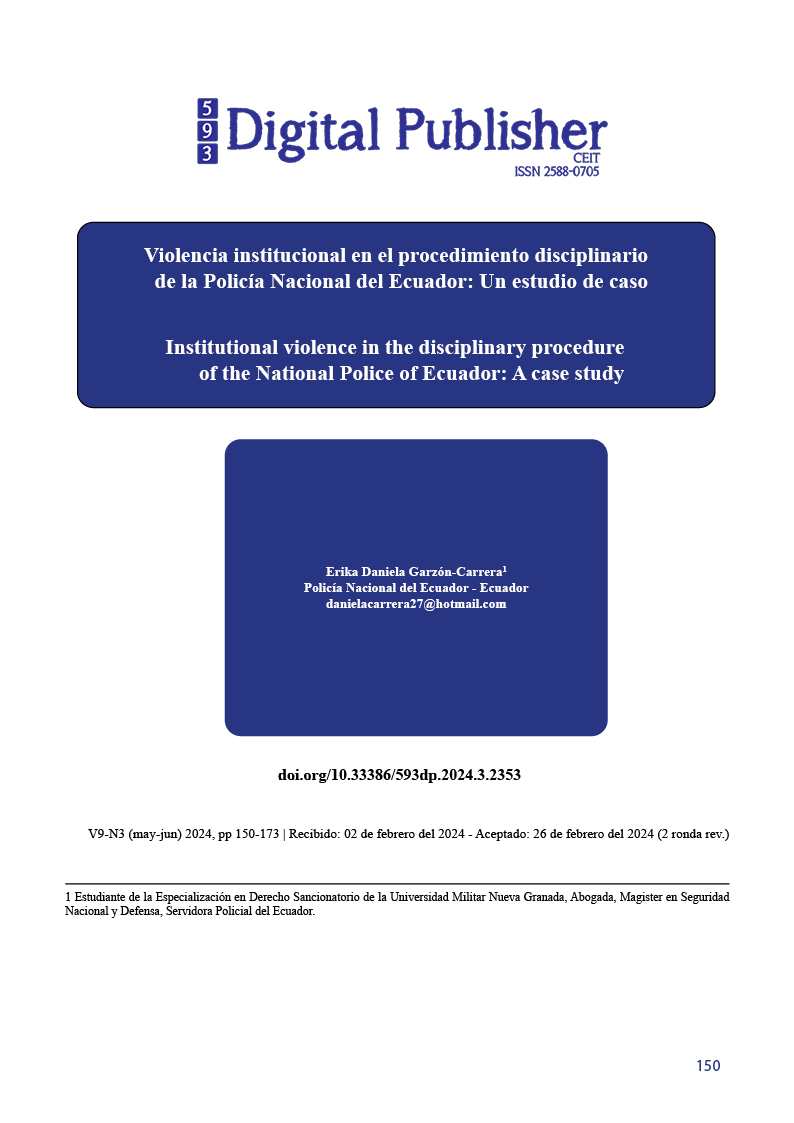Violencia institucional en el procedimiento disciplinario de la Policía Nacional del Ecuador: un estudio de caso
Contenido principal del artículo
Resumen
El presente ensayo académico revisa de manera teórica y legal la definición de violencia de género, así como los tipos que se producen dependiendo de sus manifestaciones. Partiendo de ello, identifica como casos de violencia de género, ciertas faltas disciplinarias contenidas en el Código Orgánico de las Entidades de Seguridad Ciudadana y Orden Público, norma legal que sustenta el régimen disciplinario de la Policía Nacional del Ecuador. Al hacerlo, reconoce la existencia de una víctima en el procedimiento administrativo disciplinario que se desarrolla en dicha institución, debido a la comisión de cualquiera de estas faltas disciplinarias por parte de alguno de sus miembros; víctima que no es admitida legalmente en la actualidad, razón por la cual, de manera normalizada se produce una violencia institucional que se vislumbra mediante la revictimización e impunidad cuando se presentan estos casos; aspectos que se demuestran en este documento, de manera estadística y del análisis de un estudio de caso. Por último, se examinan varios factores que deben ser considerados por parte de quienes intervienen en el procedimiento administrativo disciplinario de la Policía Nacional del Ecuador para evitar el ejercicio de esta forma de violencia, procurando en todo momento los derechos de la víctima y armonizando así la relación que se forja entre ésta y los agentes del Estado.
Descargas
Detalles del artículo

Esta obra está bajo una licencia internacional Creative Commons Atribución-NoComercial-CompartirIgual 4.0.
1. Derechos de autor
Las obras que se publican en 593 Digital Publisher CEIT están sujetas a los siguientes términos:
1.1. 593 Digital Publisher CEIT, conserva los derechos patrimoniales (copyright) de las obras publicadas, favorece y permite la reutilización de las mismas bajo la licencia Licencia Creative Commons 4.0 de Reconocimiento-NoComercial-CompartirIgual 4.0, por lo cual se pueden copiar, usar, difundir, transmitir y exponer públicamente, siempre que:
1.1.a. Se cite la autoría y fuente original de su publicación (revista, editorial, URL).
1.1.b. No se usen para fines comerciales u onerosos.
1.1.c. Se mencione la existencia y especificaciones de esta licencia de uso.
Citas
Boledón, E. (2014). Violencia institucional y violencia de género. Anales de la Cátedra Francisco Suárez, 131-155.
Carrasco, J. (2011). La nulidad procesal como técnica protectora de los derechos y garantías de las partes en el derecho procesal chileno. Revista de Derecho Universidad Católica del Norte, 49-84.
Carrión, M. (2006). El género de la violencia de género. Ciudad segura. Programa de Estudios de la Ciudad, 1.
Caso Veliz Franco y otros vs. Guatemala (Corte Interamericana de Derechos Humanos 19 de mayo de 2014).
Código Orgánico de las Entidades de Seguridad Ciudadana y Orden Público (2017).
Código Orgánico General de Procesos (2018).
Constitución de la República del Ecuador (2008).
Corte Constitucional de Colombia. (2004). Sentencia 014/04. Obtenido de https://www.corteconstitucional.gov.co/relatoria/2004/C-014-04.htm#:~:text=Por%20regla%20general%20no%20existen,internacional%20de%20los%20derechos%20humanos.
Guemureman, S., Otamendi, A., Zajac, J., Sander J. y Bianchi, E. (2017). Violencias y Violencias Estatales: hacia un ejercicio de conceptualización . Revista Ensambles primavera, 12-25.
Guerrero, P. (2008). Los derechos de las víctimas en el proceso disciplinario. Ley 734 de 2002. Bucaramanga.
Gutiérrez, C., Coronel, E., y Pérez C. (2009). Revisión teórica del concepto de victimización secundaria. Liberabit, 49-58.
Gutiérrez, F. y Escobar, C. (2010). La teoría del delito y la teoría de la falta disciplinaria en el derecho positivo colombiano (análisis comparativo). Derecho y Realidad, 217-235.
Ley Orgánica Integral para Prevenir y Erradicar la Violencia contra las Mujeres (2018).
Marquéz, Á. (2011). La victimología como estudio. Redescubrimiento de la víctima para el proceso penal. Revista Prolegómenos - Derechos y Valores, 36.
Méndez, M. (2022). Prácticas judiciales, impunidad y femicidio en Ecuador. Facultad Latinoamericana de Ciencias Sociales, 1-59.
Orentlicher, D. (2005). Cuadro sinóptico del conjunto de principios actualizado para la protección y la promoción de los derechos humanos mediante la lucha contra la impunidad. Consejo Económico y Social de la Naciones Unidas.
Organización de la Naciones Unidas. (17 de Junio de 2023). Naciones Unidas. Obtenido de Centro Regional de Información: https://unric.org/es/la-violencia-de-genero-segun-la-onu/
Piqué, M. (2017). Revictimización, acceso a la justicia y violencia institucional. Julieta Di Corleto (coordinadora), Género y derecho penal. Buenos Aires: Didot., 1-37.
Reglamento Sustitutivo al Reglamento para la Aplicación del Régimen Disciplinario del Libro I del Código Orgánico de las Entidades de Seguridad Ciudadana y Orden Público (2021).
Salas, P. (15 de 10 de 2022). La caducidad y su aplicación en el procedimiento administrativo disciplinario policial. Lima, Perú.
Sosa, M. (2021). Investigar y juzgar con perspectiva de género. Revista Jurídica AMFJN, 1-10.
Sttico, G. y Villanueva,C. (2022). LA VIOLENCIA LABORAL EN ECUADOR EN EL MARCO DEL CONVENIO 190 DE LA OIT. Entre la incertidumbre política y la baja sensibilización social. Fesminismos, 1-46.


